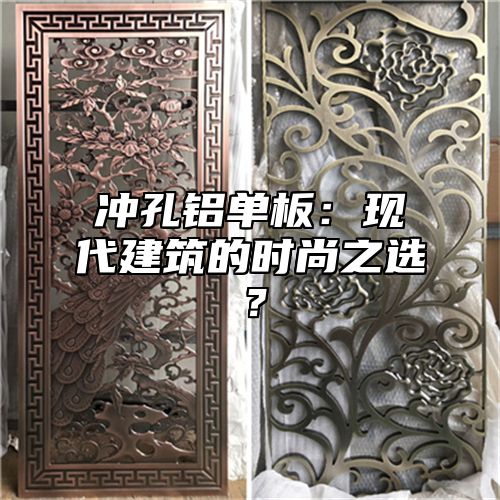

 Industry information
Industry information
Ladies and gentlemen of architecture and fashion, today let's talk about a new darling quietly emerging in the construction industry - perforated aluminum veneer. You may find this name a bit unfamiliar, but it has many applications in modern architecture. Let's explore together whether perforated aluminum veneer is the fashionable choice for modern architecture!
We need to first understand what punched aluminum veneer is. It is made of aluminum plate through punching process. This type of board has a smooth surface and a hard texture, and the punched design also makes the board look more layered. Does that sound a bit interesting? What are its advantages?
We need to talk about environmental protection. Punched aluminum veneer is made of aluminum alloy material, which can be recycled and has minimal impact on the environment. In contrast, traditional building materials such as cement and steel can have a greater burden on the environment. From this perspective, perforated aluminum veneer is definitely an environmentally friendly choice.
We need to talk about aesthetics. The design of punched aluminum veneer is flexible and versatile, and different patterns and apertures can be customized according to different needs. In this way, the appearance of the building can become rich and colorful, full of personality. Imagine a building with perforated aluminum veneer on its exterior walls, which not only reflects modernity but also showcases a unique artistic atmosphere. Isn't it very attractive?
Let's talk about practicality again. Punched aluminum veneer has good weather resistance, can withstand wind and rain, and has a long service life. It also has good fire resistance and high safety. In this way, whether used in residential, commercial, or public buildings, it can meet the demand.
However, everything has two sides. Punched aluminum veneer also has its drawbacks. For example, its price is relatively high and may not be suitable for projects with limited budgets. During the installation process, professional technicians are required to operate it, otherwise it may affect the appearance and effect.
So let's go back to whether perforated aluminum veneer is the fashionable choice for modern architecture? I don't think there is an absolute answer to this question. After all, fashion is a relative concept, and different people have different opinions. But it can be certain that punched aluminum veneer has obvious advantages in environmental protection, aesthetics, practicality, and has become a new force in the field of modern architecture.
Speaking of which, I remembered a story. A few years ago, a new building in a certain area of China adopted perforated aluminum veneer as the exterior wall material. This building has a unique shape, like a blooming flower, attracting countless tourists to come and admire. And the perforated aluminum veneer exterior wall of this building has become a major highlight in the local area.
This is just an example. In practical applications, punched aluminum veneer can also be combined with other building materials to create more innovative designs. Paired with materials such as glass and stone, it can not only reflect modernity, but also increase the layering of the building.
Punched aluminum veneer, as a new type of building material, has emerged in the field of modern architecture. Although it still has some drawbacks, it cannot be denied that it has become a fashionable choice. Perhaps in the near future, punched aluminum veneer will become a standard in the construction industry, just like glass and steel.
What I want to say is that fashion is a pursuit, but more importantly, an attitude. In the field of architecture, we should focus on the characteristics of the materials themselves, rather than blindly following trends. Only in this way can we create more architectural works that have the characteristics of the times and meet people's aesthetic needs. Punched aluminum veneer may be such a promising choice.